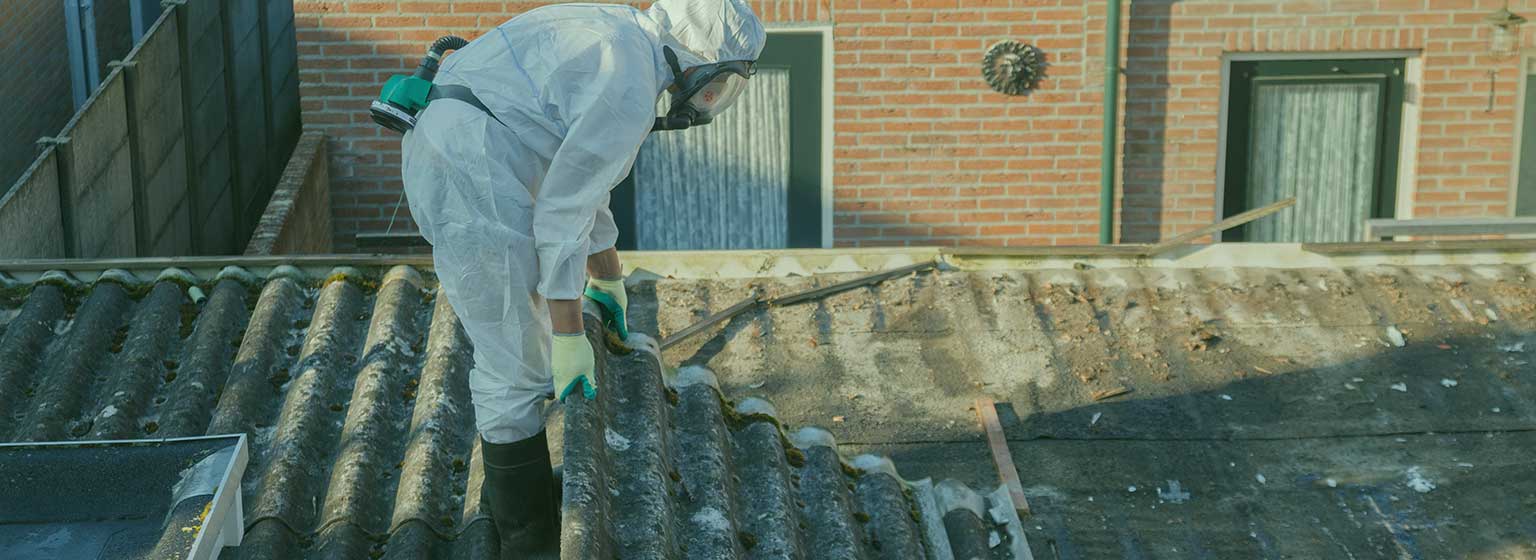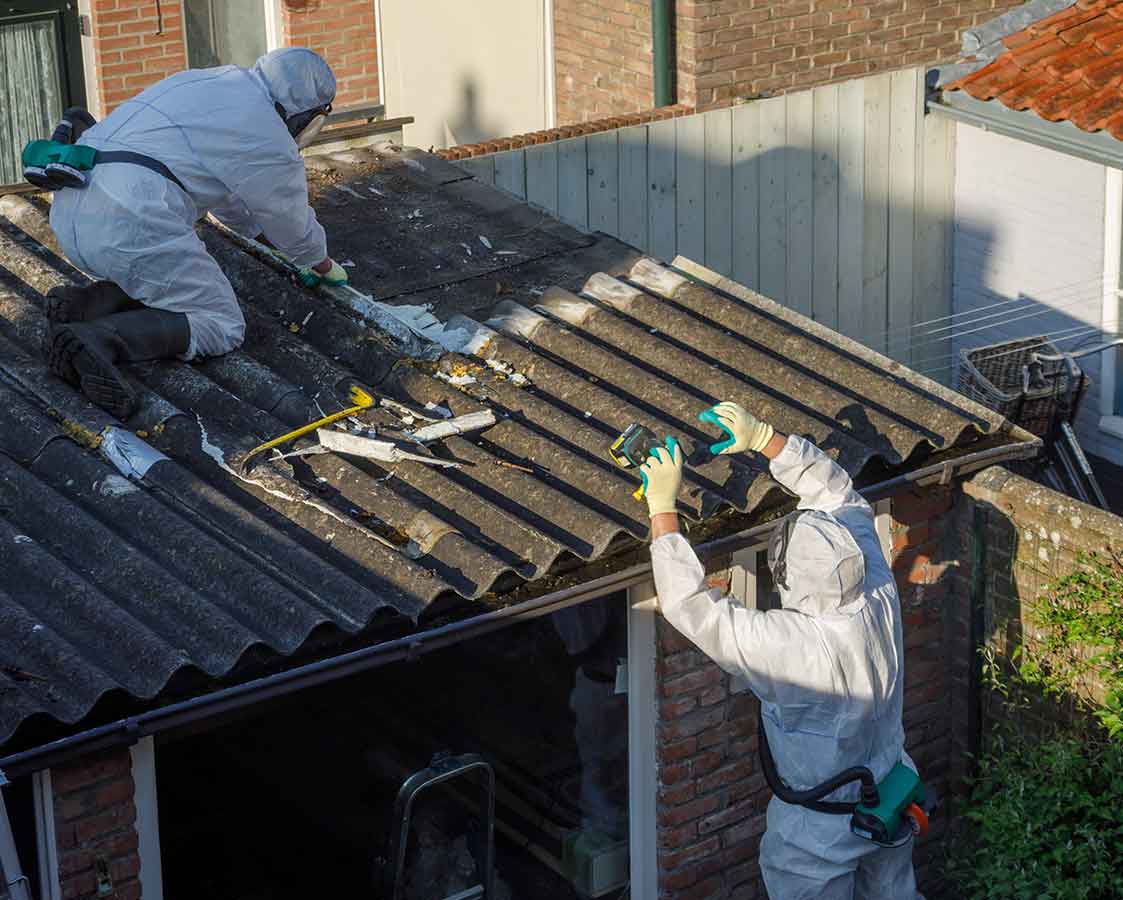The removal of Asbestos Containing Material (ACM) has the potential for people to be exposed to asbestos fibres and requires air monitoring to be in place for safety.
Asbestos air monitoring assesses the concentration of fibres within the air. Air monitoring is conducted to determine whether there have been adequate control measures implemented ensuring that worker and the public nearby are not exposed to significant amounts of asbestos fibres.
Air monitoring assumes all fibres in the air are asbestos
The asbestos monitoring assesses fibres of a specific geometry that may lodge within the lining of the lungs. The size of these fibres during monitoring are viewed under a microscope by an asbestos analyst and those counted are greater than five microns in length and less than three microns in width.
When assessing the risk to workers removing asbestos the air monitoring can be conducted to check the effectiveness of Personal Respiratory Protection (RPE). Monitoring of the asbestos workers at risk can be comprised of two Similar Exposure Groups (SEG’s) for air monitoring purposes:
- Monitoring workers when removing the asbestos within the removal area; and
- Monitoring people who are outside the work area.
Static Asbestos Monitoring
Static air monitoring to the boundary of the asbestos removal area will assist to determine if there are effective control measures in place to limit potential asbestos exposure to people outside the removal area. There may be instances where the air monitoring is conducted by sampling the air within a person’s breathing zone. This monitoring is generally done to alleviate an individual’s concern whilst working with asbestos.

Asbestos Monitoring to Conform Controls are effective
Asbestos Air monitoring whilst the asbestos removalists are taking away bonded asbestos may not be necessary. This is due to the dust suppression techniques that are employed during this type of asbestos removal and there is generally limited amount of asbestos fibres released when taking care not to break a significant amount of material. The asbestos removalists will also generally be aware of the risks and control measures required such as respirators through their training and qualifications.
It would be of benefit to undertake asbestos air monitoring through the use of personal air monitoring within the workers breathing zone during removal or different types and forms of asbestos in the air. This data may then be useful to determine the level of protection required of the respirator and determine if the asbestos removal work is “under control”.
During friable asbestos work, an air tight enclosure is usually built in which case the asbestos air monitoring of the potential asbestos release will be conducted. The asbestos monitoring will take place near the entrance to the asbestos enclosure, in the vicinity of the Negative Pressure Units (NPUs) and areas such as lunch rooms and the transit route to the asbestos waste areas.
The Australian Standard for Asbestos Air Monitoring
The method of asbestos air monitoring is commonly conducted by the process outlines within the guidance note on the membrane filter method for estimating airborne asbestos fibres by the National Occupational Health & Safety Commission. The asbestos testing method involves sampling a known quantity of air though a filter, fibres impact on the filter, whereby asbestos analysis of the filter can determine the number of fibres identified, hence the monitoring of the concentration of asbestos fibres per millilitre can be determined. The results of air monitoring are then compared against the exposure standard for asbestos. There is a general assumption that all fibres collected during on the filter as a result of the monitoring process, which are considered to then comprise asbestos.
The asbestos air monitoring pumps will required used must be pulsation free and be able to maintain a constant flow when the filter is loaded with particulates such as asbestos dust. The flow rate should be set to achieve a total of between 500 – 1000 litres over the duration of sampling asbestos. Generally flow rates of 2 l/min are used. If extremely high asbestos fibre concentrations are likely to be encountered then it may be better to sample a lesser amount of about 100 litres of air. This may be necessary to avoid overloading the filter with excessive asbestos fibres and dust.
The sampling head used during asbestos air monitoring consists of a filter holder being a conductive or metal cowl (this reduces the chance of static electricity). The length is about 50 mm which holds a filter with a diameter of 25 mm. The filter is a gridded membrane type usually of a cellulose material. The grid spacing isabout a 0.8 micrometer size pore . The filter traps the particles and asbestos fibres from the air, as it impacts the surface.
The asbestos air monitoring pumps with sampling train attached is then set at the flow which is required. The flow rate is measured using a device called a rotameter. The flow of air should be stable and is to be maintained within 10 per cent. At the completion of the air monitoring, the pumps with sampling train attached are then checked to ensure that a drop of no more than 10 percent air flow has occurred.
Laboratory analysis of Asbestos Air Monitoring
After air monitoring, the filters are then transported to the asbestos lab with the end caps in place and mounted on a microscope slide. The air monitoring filer is removed from the cowl and placed on the microscope slide. An air stream of acetone vapour is applied to dissolve the cellulose air monitoring filer in which becomes clear to be able to see the fibres. Glycerol triacetate is applied along with a cover slip protecting the filter. The slide is heated to about 50 degrees for a couple of minutes to clear the air monitoring filter in which asbestos analysis can then take place.
The air monitoring filters are analysed by a phase contrast microscope using Koehler illumination with a total magnification of approximately 400x (times). The filters from air monitoring are viewed using a Walton-Beckett circular eyepiece, which is referred to generally as the graticule. The eyepiece shows the field of view and provides asbestos fibre templates to assist in the specific fibre counting process.
Air monitoring asbestos fibres is conducted through counting through specific criteria to determine the asbestos concentration. The assessment comprises viewing and counting 100 fields of the slide. This counting will then be used to calculate the total number of asbestos fibres per 100 fields of graticule view from the monitoring.
The fibre concentration within the air is expressed as Fibres per milliliter of air (fibres/mL) and is also calculated by the formula:
C = A/a. N/n. 1/r. 1/t
Where:
C = Concentration of asbestos in the air (fibres/mL)
A = area of the filter (mm2)
a = area measure in mm of microscope graticule view
N = number of countable fibres during asbestos monitoring
N = number of fields of graticule view
R = flowrate during asbestos monitoring
T = monitoring time
When monitoring the adequacy of control measures during asbestos removal, the air monitoring results at the boundary should be expected to return a result less than 0.01 fibres/ml. This air monitoring result indicates that the asbestos removal work may continue with control measures in place.
Assessing the Results of the Asbestos Removal work
For air monitoring results between 0.01 – 0.02 fibres/ml, the control measures shall be reviewed to limited the release of asbestos in the air.
For air monitoring concentrations above 0.02 the asbestos removal work shall stop until the cause for the high concentration in the air are identified and controlled.
In consideration to asbestos exposure monitoring Safe Work Australia database which is called the Hazardous Substances Information Search (HSIS) lists the time weighted exposure (TWA) standard for all asbestos types to be 0.1 fibres/mL within the air.
For further information on asbestos monitoring or asbestos identification please contact our Sydney or Melbourne office listed below.


